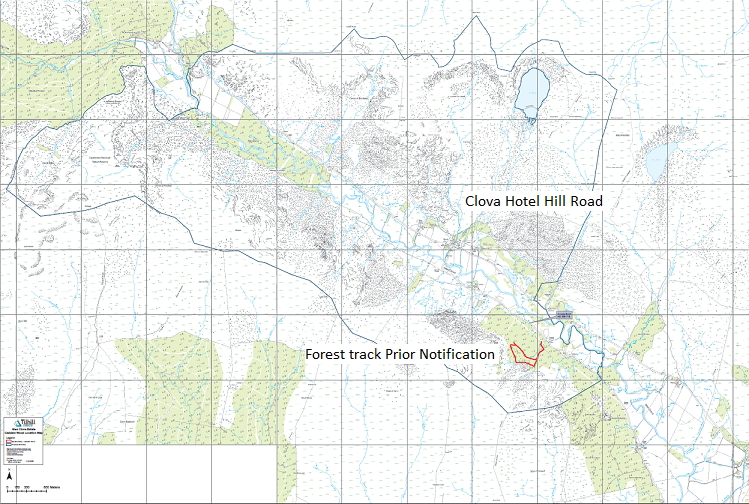 It seems that the Cairngorms National Park Authority Enforcement Notice against the Glen Clova hotel hill road (see here) has had some effect because at the end of November the Estate notified Angus Council of their intention to construct a new forestry road (see here for planning papers). Not only that, but the Prior Notification papers prepared by Tilhill Forestry Ltd included an extensive Supporting Statement and plans which enable informed comment by the public. These also reveal that the Glen Clova Estate, to its credit, had commissioned environmental surveys last year which revealed the presence of both otters and wildcat, an animal which a year ago was declared effectively extinct in the wild. This post looks at the track and the implications of the “discovery” of wildcat.
It seems that the Cairngorms National Park Authority Enforcement Notice against the Glen Clova hotel hill road (see here) has had some effect because at the end of November the Estate notified Angus Council of their intention to construct a new forestry road (see here for planning papers). Not only that, but the Prior Notification papers prepared by Tilhill Forestry Ltd included an extensive Supporting Statement and plans which enable informed comment by the public. These also reveal that the Glen Clova Estate, to its credit, had commissioned environmental surveys last year which revealed the presence of both otters and wildcat, an animal which a year ago was declared effectively extinct in the wild. This post looks at the track and the implications of the “discovery” of wildcat.
The proliferation of hill roads on the Glen Clova Estate
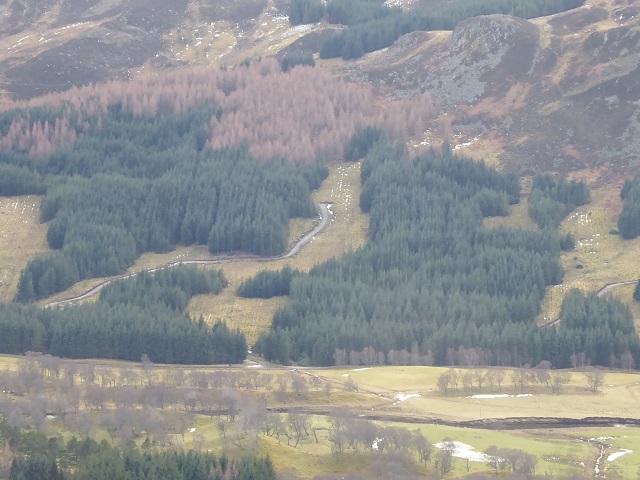
Earlier this year my attention was drawn for the first time a number of hill roads up and around forestry plantations on the south west side of the glen. I reported these to the Cairngorms National Park Authority in October – you can see from the photo that Track 1 is just as poorly constructed as the road by the Clova Hotel with mounds of earth on either side and, being too steep, will quickly erode.
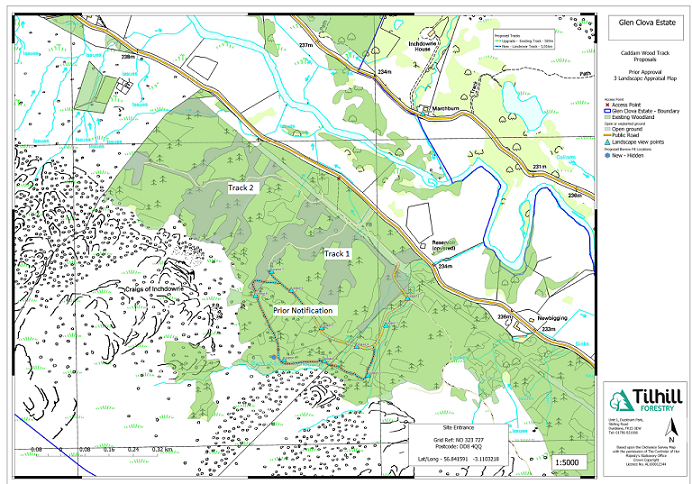
It turns out that the new forestry roads “notified” to Angus Council are intended to link up and form a wider network with Track 1:
“There is existing track infrastructure on the lower slopes which these new tracks will connect with.”
So when was this “existing infrastructure” constructed and should it have had planning approval or full consent? ( If anyone has photos which help establish WHEN these tracks were constructed – ie which show their absence or presence before 2018 please send to Nickkempe@parkswatchscotland.co.uk and I will forward to the Planners at the National Park.
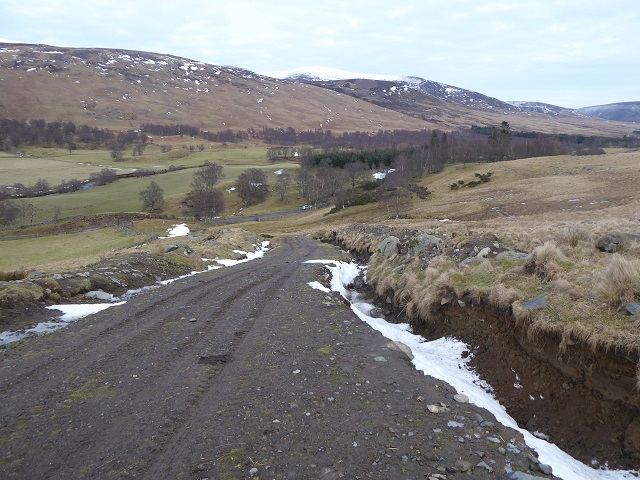
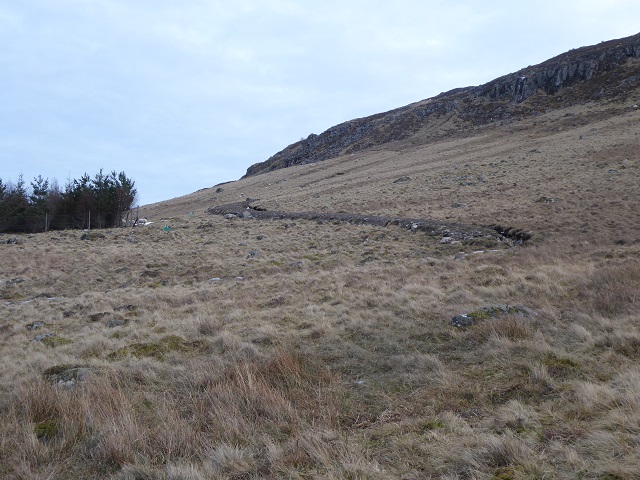
Compared to what has been happening on the Glen Clova estate over the last few years, the proposals for new and upgraded roads in the Caddam Plantation are a considerable improvement. It appears that this has happened, in part, because of behind the scenes talks with the Planning Authorities. A Prior Notification was originally submitted in May 2018, but then withdrawn (see here). The new Prior Notification provides a much fuller explanation of what is proposed. One might be tempted to say “well done” given this is so unusual in the Cairngorms National Park!
The proposed new roads are a lot narrower than most forestry roads and reasonable attention has been played to the design. The North East Mountain Trust, in their response, =draws attention to the main design issues (see here): a section of the road exceeds SNH’s recommended maximum angle for steepness (and thus is likely to erode) and there are inconsistencies in the documentation about whether the road will be 2.5m or 3.5m wide. The Planning Authorities should, with continued co-operation from the Glen Clova Estate, be able to sort this out.
The NEMT also asks that the CNPA call in the Prior Notification and decide it themselves because of the presence of wildcat.
Wildcats
The Ecological Survey for the site has not been included on the planning portal but is summarised in the Supporting Information and it it that which has revealed the presence of wildcat in the plantation:
“3.7 Protected Species
Protected species were considered in conjunction with the SAC [Special Area of Conservation] designated features. Otters, Pine martens and Wildcats formed the main focus of the survey, with the River South Esk and tributaries along the proposed route surveyed for otters. As the proposed track is located within the Wildcat Prioity Area a 200m buffer around the proposed track line was surveyed for Wildcat.
The initial survey carried out between December 2018 and February 2019. The survey noted significant presence of Wildcat and frequent indicators of otters were noted along the entire length of the River South Esk. As such there is a likelihood that without appropriate mitigation there would potentially be impacts upon protected species. A number of camera traps were deployed on suitable denning habitat along the length of the proposed track and a number of locations have positively identified Wildcats with a high pelage score. Further surveys will be required prior to commencing and during works”
Exciting news one would have thought given the reports a year ago that the wildcat was “functionally extinct” in Scotland (see here). Also, an opportunity, to demonstrate how forestry plantations might be managed to protect and save wildcat. You would, however, never know this from the response to the Planning Application by Scottish Natural Heritage, which is the government agency responsible for protecting our rarest species (see here):
“We are aware that the ecological survey found signs of protected species in the vicinity of the proposed works. We fulfil our advisory role on protected species through the provision of standing advice which is available at Planning and development: protected animals and Planning and development: birds [links given which lead you to Planning Advice Wildcat].
If there are exceptional circumstances, not covered by the relevant standing advice please feel free to get back in touch. You should consider the need for species licences as part of any development and contact licensing@nature.scot regarding any licence application.”
Why no mention of wildcat?
SNH’s own planning guidance states that:
“If wildcats could be affected by the proposal, the report must include a protection plan. The plan should include:
- measures proposed to minimise impacts on wildcats, including annotated maps and/or photographs showing the location of any measures proposed and how they relate to survey information and construction work;
- a summary of any residual impacts once the above measures are taken into account;
- details of any licensing requirements.where wildcat are found
The Prior Notification contains a wildcat toolkit (see here), which is helpful as far as it goes, but NO protection plan. So why has SNH in their response not commented on this omission and left it to the applicant to “consider the need for species licences” when its own advice says there should be a plan detailing “licensing requirements where wildcat are found”?
These omissions are particularly shocking because the construction of forest roads, as in this case, is still classed as “permitted development”. Under the Prior Notification system, which was introduced in December 2014, a Planning Authority can require the developers of such roads to seek approval but Planning authorities have the power to reject a Prior Approval but the practical difficulties involved mean that this course of action is only likely to be considered in highly exceptional circumstances; however, they can, and do, impose conditions when granting Prior Approval. While the impact of forest roads on wildlife is an added reason why all roads should be brought fully into the planning system, until this happens, unless SNH as the Public Authority with responsibility to protect wildlife objects, Planning Authorities are even more severely hampered in what they can do. It appears that SNH has abdicated all responsibility leaving the Planning Authorities to sort this out themselves.
What’s more, it appears from the Supporting Information that when the original Prior Notification was lodged it was the CNPA rather than SNH who advised the developer that:
- “The proposals are located within the Wildcat Priority Area
- Not enough information was provided with regard to Protected Species for Prior Notification recommendation”
and therefore that wildcat surveys were needed. All credit to CNPA Planning Staff but why didn’t SNH comment when, back in 2014, it was they who were responsible for creating six (now five) wildcat priority areas across Scotland?
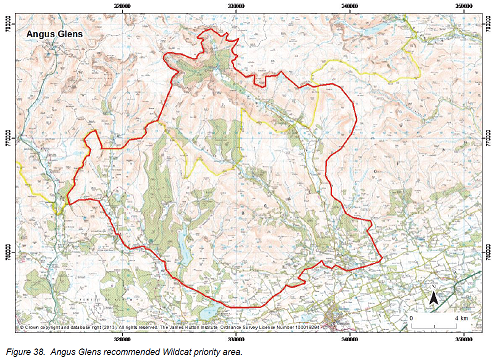
The Scottish Wildcat Action website states:
“The Angus Glens is one of the best areas in Scotland for wildcat and maintaining a strong population is key to halting and then reversing the decline of this unique mammal. Scottish Wildcat Action is a five year collaborative project involving more than 20 partners [Comment: one of which is the Scottish Gamekeepers Association}. Its monitoring of the wildcat population will inform conservation approaches, promote land management actions beneficial to Scottish wildcats (e.g. wildcat-friendly predator control), and will promote responsible cat ownership within the local community. Whilst the Action Plan has been developed within the Scottish environmental policy context, volunteer engagement is vital for collecting valuable data on this iconic species. For 60 days from late December 2015 into 2016 18 volunteers managed 57 camera traps running in the Angus Glens across some of the best habitat for wildcats in the priority area.”
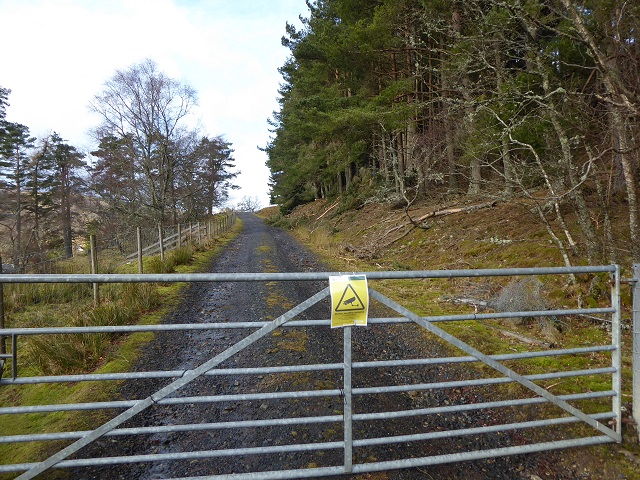
So what has SNH done in this case to monitor the wildcat population and “promote land management actions beneficial to Scottish wildcats”? Nothing. They appear to have left everything to the Clova Estate and Tilhill Forestry. That is not acceptable and not fair on the Clova Estate either.
The explanation and consequences of SNH’s failure to protect wildcats
SNH as an organisation appears to have given up on trying to protect the Scottish Wildcat in the wild and instead has shifted the focus on Scottish Wildcat Action onto captive breeding and possibly introducing the European Wildcat (a different sub-species) (see here). The story the public is now being told is that the Scottish Wildcat has declined – nae is effectively extinct – because of hybridisation.
This narrative has several consequences. :
First, all reports of wildcats in the wild, as in Glen Clova, can be ignored on the basis that they are “bound to be a hybrid” without ANY checks whether that is true or not. As a result the number of wildcats in Scotland may have been seriously underestimated.
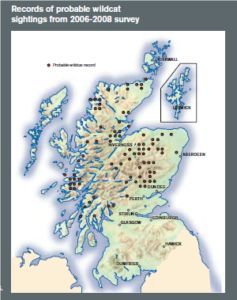
Various reports into the numbers of wildcats in the Angus Glens illustrate the problem.
Back in 2012 the final report of the Cairngorms Wildcat Project in 2012 reported:
“Records of wild-living, tabby-marked cats came from every part of the Cairngorms National Park where wooded landscapes occur, with the exception of the Angus Glens”. Just over a year later, however, there had been sufficient (Fig. 5. 12).
A couple of years later further research once more identified the Angus Glens as something of a wildcat hotspot, resulting in the Wildcat Priority Area. This illustrates how difficult the science is but should have given SNH every reason to investigate this case.
Second, the potential impacts of developments on wildcats can then be ignored. This is well illustrated by what has happened in the Clashindarroch Forest, east of the Cairngorms National Park. Clashindarroch appeared to provide a home for what was perhaps the largest population of wildcat in Scotland but then got caught up in the politics of two rival organisations, Scottish Wildcat Action, led by SNH and Scottish Wildcat Haven, the organisation which, in my view foolishly, has sued Andy Wightman MSP for defamation. Setting aside that legal dispute, the outcome of which should be announced soon, SNH appears to have left the protection of the wildcats in Clashindarroch to another member of Scottish Wildcat Action, Forest and Land Scotland. Under pressure from activitists, FLS claimed the forest operations they were conducting at Clashindarroch would have no impact on wildcat (see here). Tragically, according to reports from volunteers, in the last year the wildcats have disappeared. That is surely worthy of investigation so that any lessons learned can be applied to other places where forestry operations are planned, such as Glen Clova. Having declared the wildcat to all intents and purposes extinct, however, there is no need any longer to take precautionary measures to protect them.
Third, the role of persecution in the decline of the Scottish Wildcat is, rather conveniently, being airbrushed out of history while Gamekeepers are being given the green light to shoot any cat they see (on the grounds that it must be a hybrid). Frontline SNH staff know this only too well:

Unfortunately, SNH frontline staff appear powerless and their situation has probably been made more difficult by the decision of their bosses to include the Scottish Gamekeepers Association as a “partner” in Scottish Wildcat Action. The Angus Glens, of course, are notorious for raptor persecution and trapping predators such as weasel and stoat. Clearly, SNH staff don’t know whether or how many wildcats have been affected by this – perhaps its time that SNH as an organisation demanded that this issue be addressed?
If there are wild living cats in the Caddam Plantation, of whatever genetic purity, that is to the credit of the Clova Estate because on other estates, as the CNPA’s 2012 Report shows, there is extensive trapping and killing of cats around pheasant pens (which are found along most of Glen Clova).
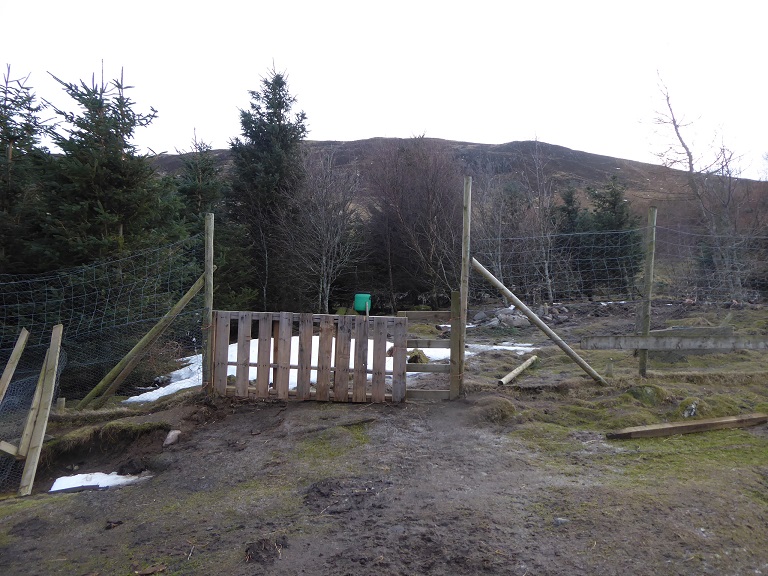
What needs to happen?
SNH set up Wildcat Priority Areas in 2014 to take forward wildcat conservation and set them the following tasks, to:
–– “Reduce the risks from feral cats and hybrids
–– Reduce harm from predator control and other land management activities
–– Promote responsible domestic cat ownership
–– Promote land management that will benefit wildcats”
The Glen Clova track application shows that SNH, as an organisation, has effectively abandoned the second and fourth tasks. The CNPA, after rightly raising the need for this forestry road application to be designed around wildcats, has responded quite strongly to Angus Council suggesting the route be amended:
“Following a review of the information submitted for the above application, we recommend this application is marked as prior approval and the Cairngorms National Park Authority will call in the application.
Either that or we suggest the Prior Notification is withdrawn and the route amended to avoid sensitive
habitats that are currently within the buffer required by the species for protection.
Our view is that the application investigates an alternative route for this track given the presence of highly sensitive species with European sensitivities.”
Unfortunately, though, by offering options (contrary to the representations of the NEMT) the CNPA left a loophole and it appears that Angus Council has decided to take on the case for themselves. This is despite them having far less expertise than the CNPA where there are staff who have carried out research into wildcats.
Parkswatch will follow closely what happens and intends to cover wildcat conservation in the Cairngorms National Park more generally in future posts. (There is an extensive literature and also plans to “re-introduce” wildcats into the National Park). Its worth stating here, however, that while care clearly needs to be taken around the way forestry is managed to protect wildcats, there is no need for this to preclude development. Indeed, the thinning of forestry plantations, as is being proposed in Glen Clova, could favour wildcats by increasing the numbers of small mammals which provide much of their diet.
The planning issue is how any one development, including permitted developments such as forest roads, might impact on wildcats. The challenge is to ensure that what scientific knowledge there is is properly used to inform the decision making process – rather than this being left to landowners or chance as happens at present.
Fantastic report about the real problem concerning the Scottish wildcats future. Obviously nobody in this country knows how many wildcats are still left out there! And the problem with DNA samples and their meaning is not even mentioned here..
I was very lucky to see a very good looking wildcat last winter (February 2020!) in the wild. It was highly emotional for me, because I felt happy and very sad at the same time. Most probably I will never ever have the chance to see this beautiful animal in the wild, at least not the “Felis silvestris grampia” what a shame! Pictures from the cat seen in the Monadhliath mountains on my website http://www.roman-inauen.com
Great pics of a good looking cat! Also in an area which will never have been surveyed during SNH claimed “national” survey. Doesn’t look like habitat in which a feral would last very long. The Wildcat saga is long and ultimately disappointing.
This is okay. My dad used to be the gamekeeper up there and he was enrolled in the wildcat project. We set up cameras and saw kittens and cats. You labels the picture of the pheasant pen wrong, it’s called a release pen, not breeding.
Thanks very much, I have updated caption to read “rearing” not breeding, Nick